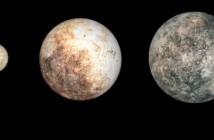The planet Pluto has been discovered in 1930 and it is considered as the second dwarf planet that is very close to the sun. On the other hand, it has been identified as the 9th planet in the solar system. The Eris is the first largest and massive planet and the planet Pluto is the second largest and enormous dwarf planet. The term Pluto is derived from the name of the Greek god of underworld or also known as Hades.
The Discovery of Pluto
In 2006, the planet Pluto had been classified as a dwarf planet since the scientists found out that it has a sufficient mass to overcome self-gravity and its orbit and the celestial bodies around the sun. The planet Pluto was discovered on February 18, 1930 by Lowell observatory. As the years passed by, some of the scientists also discovered that Pluto has five moons namely Charon, Hydra, Nix, Kerberos and Styx.
The Charon moon was discovered in 1978, the moons Hydra and Nix were both discovered in 2005, Kerberos was in the year 2011 and Styx was revealed in 2012. The planet Pluto has a diameter of 2, 306km while Eris has 2,326km. The planet Pluto is smaller than the other moons like Titan, Callisto, Triton, Europa, Earth’s moon and Ganymede. Its size is 66 percent of the diameter of the Earth’s moon and 18 percent of the mass. It also has an inclined and eccentric orbit that is about 7.4 billion kilometers away from sun. It simply means that the planet Pluto is merely close to the sun as compared to the planet Neptune.
Exploration of Pluto
According to a research, there are no spacecrafts that attempted to visit the planet Pluto but in 2015, the New Horizons spacecraft has been scheduled to fly going to Pluto as well as in the Kuiper Belt. The exact location of Pluto was being predicted by Lowell in the year 1915 that is also associated with the actual location of the planets Neptune and Uranus.
Pluto’s Atmosphere
According to some scientific studies, Pluto also has an atmosphere. When the planet Pluto is merely close to the surface of the sun, they found out that it forms a tiny atmosphere that is composed of nitrogen, carbon monoxide and methane. When the planet Pluto travels away from the surface of sun, the atmosphere freezes back to a solid state. It simply means that this kind of dwarf planet also consists of an atmosphere even though the temperature of it is about 44 degrees.
During the observations of some of the scientists and astronomers regarding this planet, they have also found out the actual calculation of carbon dioxide, methane and nitrogen. In 2015, the spacecraft of New Horizons will fly to Pluto to gather additional and valuable information regarding the possible facts and observations regarding this planet. The team also wants to answer the questions of most scientists. Most of the scientists and astronomers are hoping that the team will give them the accurate data and possible information that will play a vital role in their upcoming researches and studies.


